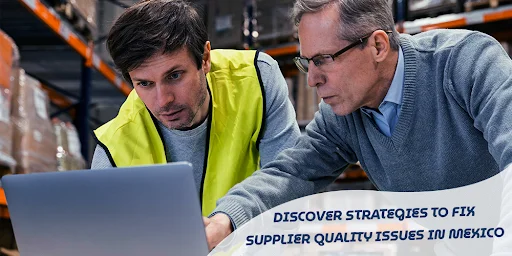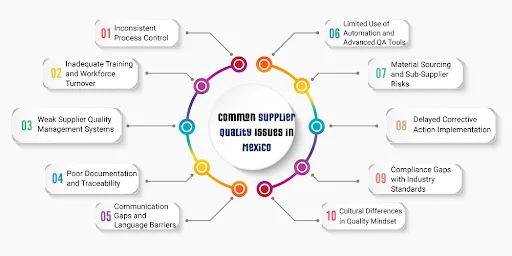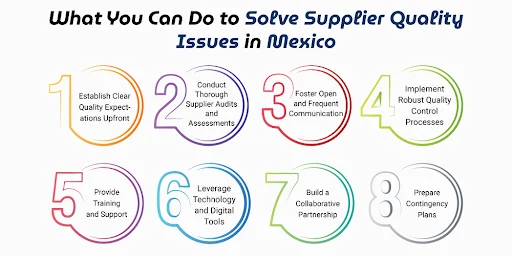How To Manage Difficult Suppliers
Most supplier problem resolutions do not start at the production stage. Many problems begin from working with suppliers whose...
By AMREP | Posted on May 21, 2025
Mexico has emerged as a major hub for manufacturing and supply chain operations, especially for companies in the automotive, aerospace, electronics, and medical device sectors. Its strategic location, skilled labor force, and trade agreements like USMCA make it an attractive choice for nearshoring. However, while Mexico offers many advantages, businesses sourcing from the region often encounter specific supplier quality challenges. Let’s explore the most common supplier quality issues in Mexico and how companies can mitigate these risks through proactive quality management.


When working with suppliers in Mexico, several recurring quality challenges often arise that can impact production efficiency and product reliability. Understanding these common issues is the first step toward effective management and improvement.
One of the most frequent quality issues stems from lack of process standardization. In many factories, especially those operating under tight budgets or limited oversight, processes are not consistently documented or followed. Variations in production routines can lead to inconsistent product quality, higher defect rates, and delays.
Although Mexico has a growing pool of skilled labor, many suppliers, especially in lower-tier or rural locations, struggle with high employee turnover and insufficient training programs. This leads to human error, improper equipment use, and quality control oversights.
Many small to mid-sized Mexican suppliers may lack comprehensive quality management systems or fail to effectively implement the ones they have. This can result in poor traceability, ineffective root cause analysis, and limited continuous improvement efforts.
For insights on maintaining supplier quality from a distance, check out our detailed guide on How to Monitor Supplier Performance Remotely: Tools & Tactics.
A recurring issue in Mexican supply chains is incomplete or inaccurate documentation—from inspection reports and batch records to certificates of compliance. Without clear records, it's hard to trace the source of defects or verify that standards were met.
Although many Mexican manufacturers have bilingual staff, miscommunication still occurs, especially with technical requirements, product specifications, or quality standards. Nuances may be lost in translation, leading to misinterpretation and nonconformities.
Some suppliers, particularly small or mid-tier ones, still rely heavily on manual inspection and outdated quality tools, which increases the risk of human error and variability in quality checks.
Suppliers in Mexico may themselves depend on imported raw materials or sub-suppliers whose quality is beyond their immediate control. Variations in incoming material quality can significantly affect the end product.
When defects are identified, some suppliers in Mexico are slow to implement effective corrective and preventive actions (CAPA). This may be due to limited resources, lack of urgency, or poor root cause analysis capabilities.
In regulated industries like automotive, aerospace, and medical devices, noncompliance with industry-specific standards can be a critical issue. This is especially true when dealing with smaller suppliers unfamiliar with stringent export or certification requirements.
In some cases, cultural perceptions of quality and customer expectations may differ. Suppliers may prioritize production speed or cost-saving over defect-free output unless explicitly incentivized otherwise.
Addressing these challenges requires a structured and proactive approach.

Implementing targeted strategies and proactive measures can help you overcome these challenges and build a more reliable and efficient supply chain.
Start by clearly defining your quality standards and specifications in contracts and agreements. Ensure your suppliers understand the technical requirements, testing methods, and acceptable tolerances. Consider creating detailed quality manuals or inspection checklists tailored for your Mexican suppliers.
Before onboarding or renewing contracts, perform comprehensive audits to evaluate your supplier’s quality management systems, manufacturing capabilities, and process controls. Look for certifications such as ISO 9001, IATF 16949 (for automotive), or other relevant standards. Regular onsite audits can also help monitor ongoing compliance.
Language and cultural differences can create barriers. Invest time in building strong relationships with your suppliers, leveraging bilingual staff or translators when necessary. Hold regular meetings to discuss quality performance, challenges, and continuous improvement opportunities.
Work with your suppliers to establish in-process inspections, statistical process controls (SPC), and final product testing. Share data transparently and address defects immediately. You might also consider deploying third-party quality inspectors or partnering with local quality service providers to perform independent inspections.
Sometimes quality issues stem from gaps in knowledge or training. Offer training programs on your quality requirements, best practices, or lean manufacturing techniques. Supporting your suppliers in upskilling can result in better processes and fewer defects.
Utilize software for supplier quality management (SQM) to track supplier performance, defect rates, and corrective actions in real-time. Tools like ERP systems integrated with quality modules or mobile inspection apps can provide visibility and faster response times.
Rather than an adversarial relationship, aim for a partnership approach. Work collaboratively with your Mexican suppliers to identify root causes of quality issues and develop corrective action plans. Encourage continuous improvement initiatives such as Kaizen or Six Sigma projects.
Despite best efforts, some quality issues may persist. Have backup suppliers vetted and ready to step in if needed. Maintain buffer stock or flexible production schedules to minimize disruptions.
While addressing supplier quality issues requires effort and resources, the benefits are significant:
Poor supplier quality can lead to defective parts, inconsistent materials, or substandard final products. This results in scrap, rework, customer complaints, and even product recalls, all of which come with direct costs and reputational damage.
By investing in upstream quality control, such as regular audits, certifications, and preventive measures, businesses can drastically reduce the likelihood of failures that occur downstream in production or in the customer’s hands.
Product quality directly impacts customer satisfaction and loyalty. When poor supplier inputs compromise the final product, customers don’t blame the supplier—they blame you. High-quality suppliers enable consistent performance, fewer complaints, and improved product reliability, all of which reflect positively on your brand.
A reputation for quality can be a powerful competitive advantage and often allows companies to command premium pricing and better customer retention.
Suppliers with poor quality management are more likely to experience disruptions, whether from material inconsistencies, failed inspections, or compliance issues. These problems can lead to delays, production stoppages, and missed delivery deadlines.
Investing in supplier quality helps build a more resilient and predictable supply chain. With robust systems and trained personnel in place, suppliers are better equipped to deliver consistent output even under pressure.
Quality issues often ripple through the production process, causing bottlenecks, machine downtime, and labor inefficiencies. By reducing the need for incoming inspections, rework, and emergency interventions, high supplier quality contributes to smoother operations and lower overhead.
Better inputs result in fewer process disruptions, which means faster cycle times, leaner inventory, and improved throughput, benefiting your bottom line.
In regulated industries such as automotive, aerospace, and healthcare, noncompliance with standards like ISO, IATF, or FDA regulations can result in serious penalties, delays, or loss of certification. Many of these compliance failures originate at the supplier level.
When you invest in your suppliers’ quality systems through audits, training, and joint improvement initiatives, you not only avoid compliance risks but also demonstrate due diligence to customers and regulators.
High-performing suppliers are not just vendors—they are strategic partners. When suppliers have a strong quality culture, they are more likely to collaborate on process improvements, suggest innovations, and proactively solve problems.
Investing in supplier quality fosters a mindset of continuous improvement, which can lead to cost savings, faster time-to-market, and new product opportunities over time.
While low-cost suppliers may appear attractive on paper, poor quality often results in hidden costs such as higher defect rates, increased inspection, delayed shipments, and even lost customers. In contrast, high-quality suppliers reduce your total cost of ownership by delivering reliable, defect-free components consistently.
In the long run, paying a bit more for quality up front can result in significant cost savings and reduced risk exposure across the supply chain.
Mexico offers tremendous opportunities for manufacturers and businesses, but supplier quality challenges can undermine those benefits if left unchecked. By setting clear expectations, maintaining open communication, leveraging audits and technology, and fostering collaborative partnerships, you can effectively solve supplier quality issues and build a strong, resilient supply chain.
To address quality challenges with your Mexican suppliers effectively, start by performing a detailed evaluation of their processes and capabilities. Collaborating with a supplier quality management company that understands local standards and operational practices can make a significant difference. Taking strategic, informed steps now will enhance product consistency, boost customer trust, and strengthen your competitive position.
At AMREP, we specialize in helping businesses navigate the complexities of global sourcing by ensuring supplier quality at every level. With decades of on-the-ground experience in Mexico and other key manufacturing regions, we provide the oversight, expertise, and continuous improvement support needed to turn quality challenges into operational advantages.
Partner with AMREP to build a stronger, more reliable supply chain—because quality starts at the source.
Contact Us To See What We Can Do
Call Us
Mon - Sat 9.00 - 18.00
Sunday Closed


10 - April 2022
10
April
2022
Most supplier problem resolutions do not start at the production stage. Many problems begin from working with suppliers whose...

06 - April 2022
06
April
2022
With the rush of the automotive and aerospace industries into Mexico over the last few years, it’s been an extremely busy...

14 - February 2024
14
February
2024
New Product Introduction (NPI) is the process of taking a product from the initial concept stage through to mass production and commercialization ...
